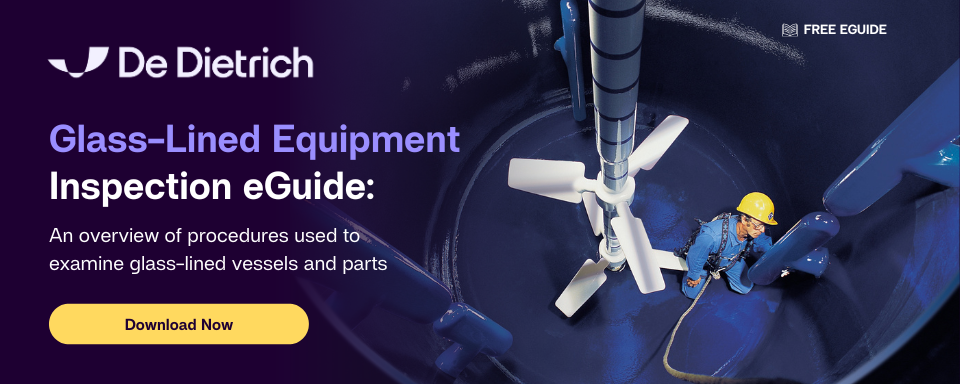A Step-by-Step Guide to Glass-Lined Equipment Inspection
Note: This blog post is designed to provide a general overview of the procedures used to inspect glass-lined equipment. Its contents should only be used as a guideline; specific instructions from the vessel supplier should always be followed. Only well-qualified technicians should carry out these inspections. Damage to the glass lining can occur during some inspection techniques if they are not done properly.
 The following information has been extracted from Materials Technology Institutes Repair and Damage Assessment for Glass-Lined Equipment, written by Sal Falcone and Bert Moniz. These important points serve as an excellent resource for plant managers, maintenance engineers, and any other personnel who works in close contact with glass-lined equipment and systems.
The following information has been extracted from Materials Technology Institutes Repair and Damage Assessment for Glass-Lined Equipment, written by Sal Falcone and Bert Moniz. These important points serve as an excellent resource for plant managers, maintenance engineers, and any other personnel who works in close contact with glass-lined equipment and systems.
Inspection Frequency
To ensure the continued performance and well-being of your glass-lined steel equipment, regularly scheduled inspections should be conducted to examine the interior and exterior of the vessel as well as the associated components (e.g. agitators, baffles, etc.). This chart lists the recommended frequency of inspections for each different type of equipment:
Type of Equipment |
Inspection Frequency |
|
Storage Tanks |
3 to 5 years |
|
Vessels with agitators |
Annually |
|
Vessels without agitators |
1-2 years |
|
Repaired equipment: Plugs <1 inch |
After 1 month, 6 months, then annually |
|
Repaired equipment: Plugs >1 inch |
After 1 month, 3 months, 6 months, then annually |
|
Equipment that undergoes service changes |
After each service until history is established then at normal frequency |
Preparing for an Inspection
Prior to inspecting a vessel and its components it is important to obtain documentation from previous inspections and services. These documents will provide a necessary reference regarding repair locations, the condition of existing plugs and patches, as well as the identification of any other issues that were noted during the last examination. This data will help benchmark the condition of the equipment during the last inspection and identify the location of specific areas that need close analysis. The vessel must also be thoroughly cleaned and dried to remove any product that could endanger the personnel entering the vessel or inhibit the testing procedures and results. Once you have taken care of these steps and you have secured a certified technician, you are ready to have your equipment inspected!
External Inspection
External inspection refers to the examination of all exterior parts of the vessel, including the shell, jacket, lifting lugs and supports. The following areas should be closely looked at during this step in the inspection process:
Shell and Jacket
- Areas around welds and bolting
- Nozzles and crevices (e.g. between back-up flange and underside of nozzle stub)
- Nozzle sealing surfaces (gasket leakage can lead to corrosion)
- Gasketed joints
- Insulation and coating system
- Uninsulated areas
Inside Jacket
- Impingement plates of all jacket nozzles
- Steel surface (can be examined via inspection ports)
- Bottom jacket clean-out port (checking for accumulated sludge)
Lifting Lugs and Supports
- Welds
Additionally a jacket thickness test can be performed using an ultrasonic thickness gauge. It is important to measure in the same locations during each inspection in order to accurately note any changes to the metal thickness.
Internal Inspection
The activities included in an internal inspection include visual examination, glass thickness measurement, and spark testing. Visual examination usually consists of a technician entering a vessel, however, there are some instances when remote visual inspection via cameras is used. Here we’ve outlined the issues to look for during the following visual examination procedures:
Inspection of plugs and patches
- Loosening and corrosion
- Spaces between the repair and the glass surface
- Embrittlement of tantalum
- Rust stains around edges
Mechanical Seal and Agitator Drive Inspection
(Note: Mechanical seal should be removed to enable full inspection. During inspection of drive gearing, oil should be changed)
- Leakage or damage
- Corrosion in mechanical seal area of the agitator and under split-ring flanges
Glass Thickness Measurement
This procedure measures the glass thickness using a magnetic coating thickness gauge. Glass thickness measurements should always be taken at the same locations during each inspection in order to accurately evaluate if any erosion has taken place.
Spark Testing
During spark testing, the entire glass-lined surface is inspected and any chips, cracks, pinholes and other defects should be documented and marked. It is important to carefully inspect nozzles and other internal attachments, as these areas are extra susceptible to damage. There are two apparatuses available for spark testing:
- DC spark testers – preferred method, portable and less hazardous; requires vessel to be grounded
- AC spark testers – must be used when examining removable agitators and other equipment that are completely glassed and can’t be grounded
Repaired areas should be avoided during this procedure as the voltage from the spark tester can damage the PTFE (instead, repair areas are inspected thoroughly during the visual examination). Due to the residual charges that build up during this procedure, spark testing should be the last test conducted before exiting a vessel.
StatiFlux Testing
Additionally, StatiFlux testing can be conducted if the vessel has undergone mechanical or thermal stress which could cause cracks in the lining that can’t be detected with visual inspection or spark testing. During this test, a special talc based powder is electrically charged and sprayed onto the glass lining to reveal any cracks.
The following forms and checklists are used by De Dietrich service technicians use a series of forms and checklists during vessel installation and inspections, including:
- Vessel inspection checklist
- Vessel Glass Thickness Inspection Report
- Vessel Exterior Inspection Sheet
- Agitation System Checklist
- Accessory Checklist
- Plug Chart
- Vessel Start-up Checklist
For more information on glass-lined equipment inspection and other field services, contact our service department. Or download our free eGuide on Glass-Lined Equipment Inspection:

